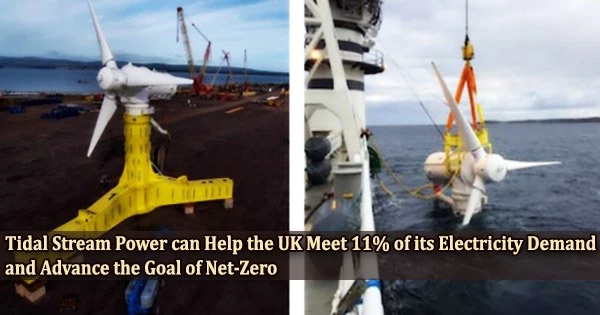According to new research, tidal stream power has the potential to provide 11% of the UK’s current annual electricity needs and play a key role in the government’s push for net-zero. Tidal energy is a renewable source of power generated by the tidal movements and ocean currents that occur naturally. These technologies include paddles and turbines, among others.
A predictable and dependable method of assisting in meeting the nation’s future energy needs, according to scientists from around the UK, can be found in harnessing the force of the ocean’s tidal streams.
But in order for it to happen, government investment will be needed to speed up innovation and lower its cost so that later projects can offer affordable electricity. According to the authors, these chances are currently unavailable because of the way the government’s funding programs for renewable energy are set up.
A tidal stream generator, also known as a tidal energy converter (TEC), is a device that harnesses the power of the tides and other moving bodies of water. However, the name is frequently applied to devices made to harness the power of run-of-river or tidal estuary areas.
In the past, 18 MW of tidal stream capacity roughly 500 times smaller than the UK’s present offshore wind capacity was installed with the assistance of government subsidies. The tidal stream industry is currently on a strong cost-reduction track thanks to this relatively modest government support.
In regions where there is a sizable variation in area between high tide and low tide, engineers devised ways to exploit tidal movement to create energy during the 20th century. Each technique turns tidal energy into electricity using specialized generators.
Cost-cutting efforts have slowed, nevertheless, as money was no longer available. To make it cost-competitive with gas turbines, biomass, and nuclear, such support must be expanded.
Our study shows there is considerable evidence to support an estimate that the UK and British Channel Islands’ tidal stream energy resource can provide 11% of our current annual electricity demand. Achieving this would require around 11.5 GW of tidal stream turbine capacity to be installed, and we currently stand at just 18 MW. It took the UK offshore wind industry approximately 20 years to reach 11.5 GW of installed capacity. If tidal stream power is going to contribute to the net zero transition, time is of the essence.
Dr. Danny Coles
The least expensive and environmentally harmful of the four primary types of tidal power generating are tidal stream generators. Tidal streams, barrages, and tidal lagoons are the current three methods for obtaining tidal energy.
The study also looked at how such future changes would affect the environment, however it found no evidence that the following stage of tidal stream development will have a materially negative influence on the environment. The effects on the physical environment are anticipated to be orders of magnitude less severe than those brought on by climate change.
Just one day before world leaders gather in Glasgow for the COP26 meeting to debate the need for international agreements on sustainable energy, the study headed by the University of Plymouth and published in Royal Society Proceedings A was made public.
Dr. Danny Coles, Research Fellow at the University of Plymouth and the study’s lead author, said:
“Our study shows there is considerable evidence to support an estimate that the UK and British Channel Islands’ tidal stream energy resource can provide 11% of our current annual electricity demand. Achieving this would require around 11.5 GW of tidal stream turbine capacity to be installed, and we currently stand at just 18 MW. It took the UK offshore wind industry approximately 20 years to reach 11.5 GW of installed capacity. If tidal stream power is going to contribute to the net zero transition, time is of the essence.”
The Pentland Firth and Orkney Waters, Scotland, and the Channel Islands have the biggest tidal stream potential, but both would need substantial grid infrastructure to connect them to heavy demand centers.
Parallel to that, however, other locations on the South Coast of England and in the Bristol Channel might be developed more quickly because to their proximity to the already-existing grid infrastructure and demand centers.
As the penetration of renewable energy rises, the UK government recently identified the grid integration of variable generation as a major concern. The cyclic, predictable character of the tides can help the grid in comparison to other variable power resources like wind, including supply-demand matching, for example, according to this new research.
The UK Government has already committed to a Net Zero greenhouse gas emissions target by 2050 and, in 2017, almost 30% of the UK’s energy was generated through renewable technologies such as wind and solar power.
But even though wind and solar will be the main sources of supply to meet this demand by 2050, a wide generation technology mix will be necessary to keep the lights on.
Co-author Professor Beth Scott, of the University of Aberdeen, said: “This paper provides such an important and timely message for the world, and especially the UK government, to fully understand the strategic use of predictable tidal stream energy. At the moment the UK is leading the world in both the technological and environmental research aspects of tidal stream energy developments and supporting that lead now will rapidly increase the UK’s goal of sustainable net-zero energy production.”
Another co-author, Professor Philipp Thies of the University of Exeter, added: “This is an extensive review on the state of the art and opportunities for tidal stream energy. There are still engineering challenges ahead, but this source of low carbon energy is technically feasible and an important element of future net zero energy generation.”
















